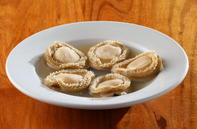Of a whole abalone, about 30% is abalone meat, 22% is shell made of calcium carbonate and the rest is intestines. Abalone can be sold live and whole or the meat may be processed into a variety of forms, depending on the market’s preference.

South Africa is now the largest producer of live abalone and abalone products outside of Asia. The largest producer is China, where the focus shifted to the production of Haliotis discus hannai, the preferred species for export into Japan. This species is native to Japan and highly prized. Larger size abalone can reach prices of up to US$ 1700/kg.
The Singapore market prefers ‘ready to eat’ abalone, while Australia is targeting Japan, Singapore, Taiwan, and China with the high quality of its wild stock branded as “Australian Wild Abalone”, known as AWA. Chile, Mexico and the USA are servicing niche markets within China with the Japanese species Haliotis discus hannai and the Red California abalone species.
In China, abalone is known as bàoyú.
Abalone Products from South Africa
The South African abalone industry produces products of extremely high quality and is well-developed; from using advanced locally-formulated abalone feed, effective breeding and spawning practices to well-established marketing and export channels.
The South African abalone industry is based solely on the South African abalone species Haliotis midae and is positioned as a premium product in both China and Japan.
South African abalone products include live, dried, processed, smoked and canned abalone.Due to the large variety of products, abalone can be harvested throughout the year in a variety of sizes.
Ready-made flavoured abalone is increasing in popularity to the younger Asian generation. Double-braised abalone, packed in a special plastic pouch is also available and is made up to client’s specifications, sometimes with bespoke sauces. Abalone is also dried according to traditional Asian methods and can range from 25 g to 80 g per piece.
Live South African Abalone
Live abalone is harvested and air-freighted to wet markets and restaurants, in perfect healthy live condition, adhering to the strict quality controls, enforced by the National Regulator for Compulsory Specifications (NRCS) of South Africa.
Live abalone can be graded from 50 – 70 g up to 200 – 300 g per piece and will be determined by the specific order. For example, 250 kg of 90 - 110 g. Matt Naylor from HIK Abalone Farm explains: ‘The specified size is often determined by a specific abalone dish the chef has planned.
Abalone is specially harvested and graded to fulfil the order and conditioned for a few days in very clean seawater. The live animals are then packed and airfreighted to the restaurant, where they are placed in a tank with seawater in the restaurant. Customers then choose individual abalone they would like to buy or for the chef to prepare.
Fresh abalone is perceived as of higher quality than processed abalone. Fresh, live South African abalone is prefered in Cantonese restaurants in Hong Kong, while canned or dried abalone mostly used for home preparation.
For live abalone, it is paramount that tank-to-tank logistics are in place. This means that live abalone needs to be transported from its tank in South Africa to its holding tank in an Asian restaurant, within 48 hours.
Canned Abalone
South African canned abalone is also prefered above that of the Australian competition as South African abalone are canned free without the use of preservatives or bleach. Canned abalone also requires strict grading to comply with the number of pieces per can. The demand and price are, to a certain degree, determined by the size of individual abalone meat inside the can.
Abalone Shells
Abalone shells are used as ashtrays, soap holders or made into jewellery. In New Zealand, the Maori people used the abalone shell in warrior artwork. It is believed the shell strengthens the body and the heart of the warrior.
The abalone shell is also used in the puberty ceremony of Apache girls, an indigenous nation in Northern America. It is worn on the forehead and symbolises the connection between the girl and her spiritual heritage and ability to heal.
Many cultures believe in the abalone shell as a symbol of water and it is often used in cleansing ceremonies.
By Marinda Louw
For bulk or export enquiries please use the enquiry link below.